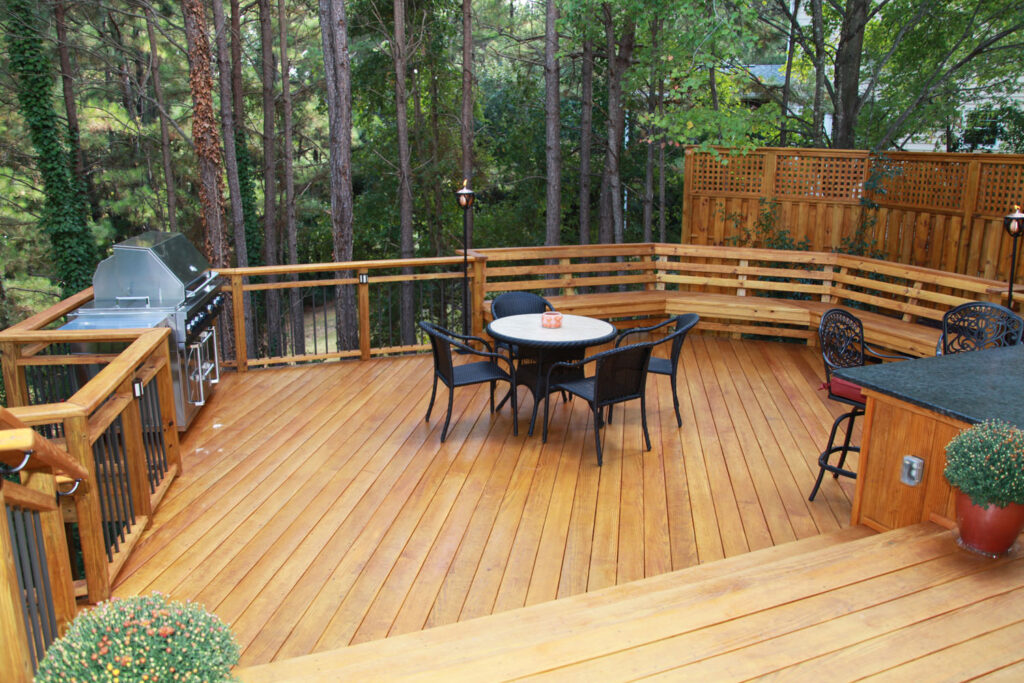Ger�ek Ah?ap vs. Kompozit veya Plastik Zemin Kaplamas?
GERÇEK AHŞAP vs
Kompozit Zemin Kaplaması
Bazı ev sahipleri ve inşaatçılar kompozit veya plastik zemin kaplamasını tercih ederken, basınçla işlenmiş Güney Çamı, çeşitli nedenlerle hala en popüler seçimdir.
Güzellik, katma değer ve konfor, Southern Pine güverte ve sundurmalarının bu kadar popüler olmasının nedenlerinden sadece birkaçıdır, bu “açık hava odalarının” bir evin açık hava eğlencesi ve rahatlama için yaşam alanını genişlettiğinden bahsetmiyorum bile.
Ancak güvertenin yürüme yüzeyi olan zemin kaplamalarının işi zor. Zemin kaplaması, hava koşullarından ve yaya trafiğinden kaynaklanan sert günlük cezalar alır ve güvertenin en görünür kısmı olarak, yüksek uzun vadeli uyum, bitiş ve görünüm beklentilerini karşılamaları gerekir.
Ahşap, dış mekan projeleri için en iyi çevresel seçimdir
, çünkü diğer zemin kaplama ürünlerinin üretilmesi ahşaptan sekiz kat daha fazla enerji gerektirebilir.
Masif ahşap, genellikle polietilen, polipropilen, polistiren veya polivinil klorür gibi petrol bazlı malzemelerden yapılan kompozitlerin aksine, doğal olarak yetiştirilen ve yenilenebilir bir üründür.
Southern Pine zemin kaplaması veya plastik/kompozit seçeneği arasında karar vermek istiyorsanız, aşağıdakileri göz önünde bulundurun:
- Estetik
- Masraf
- Dayanıklılık
- Çevresel Etki
- Uzun ömürlülük
- Bakım
Sonuç olarak, ahşap ve kompozit zemin kaplaması arasındaki seçim, önceliklerinize ve tercihlerinize bağlıdır. Doğal bir estetiğe değer veriyorsanız ve bakıma zaman ayırmaya istekliyseniz, ahşap zemin kaplaması doğru seçim olabilir.

| Question | Real Wood | Composites or Plastics | What are the facts? |
|---|---|---|---|
| Natural Appearance? | Yes | No | There is no substitute for the look and feel of real wood. Wood decking looks warm, natural, and blends beautifully with the landscape. Plastic or plastic composites, even with faux wood grain, still look and feel artificial. |
| Comfortable under foot? | Yes | ? | Wood is a naturally insulating material and does not conduct heat or cold like metal or plastic. In direct sun, some plastic or composite decking can become much hotter than wood, hot enough to burn or blister feet. |
| Safe to use? | Yes | Yes | Pressure-treated wood is safe for people, pets, and the environment. Furthermore, advanced preservative formulations contain no arsenical or chromium compounds while being resistant to decay and termite attack. |
| Renewable? | Yes | No | Wood is the only building material that uses the sun’s energy to renew itself in a continuous cycle. Sustainable forestry practices ensure our supply of homegrown wood will be maintained for future generations. On the other hand, plastics are derived from finite petroleum resources. |
| Earth-friendly? | Yes | No | Manufacturing wood products uses less energy and produces less air and water pollution than other building materials. Manufacturing plastic decking requires more energy to produce than a comparable piece of wood decking. |
| Strong? | Yes | No | Wood can be up to four times stronger than plastic or composite products and possesses up to nine times the stiffness of artificial decking. Wood decking is not affected by heat, which tends to promote creep (sagging) in composites over time. |
| Needs maintenance? | Yes | Yes | Despite claims to the contrary, all decking requires maintenance. Periodic cleaning and application of a water-repellant sealer is all that is needed to keep a wood deck in top shape. A good scrubbing usually removes most stains on wood decking, too. |
| Decay/termite warranty? | Lifetime limited | Limited | Wood preservative manufacturers typically offer a limited lifetime warranty against decay and termite attack in residential use. Plastic or composite deck manufacturers typically offer a limited warranty. |
| Standardized product? | Yes | No | Approved inspection agencies monitor lumber production and pressure-treating facilities. These agencies operate under rigorous protocols to enforce uniform performance and quality standards approved by the American Lumber Standard Committee and/or the American Wood Protection Association. |